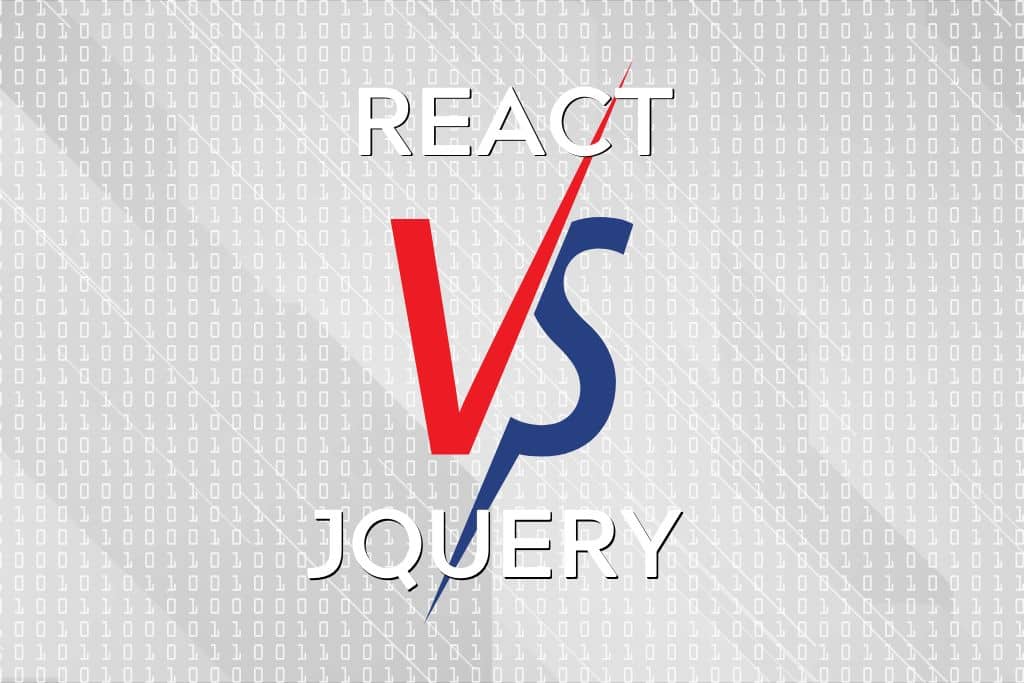Both React and jQuery are extremely popular JavaScript libraries that aid web developers with frontend tasks. Think DOM manipulation, UI design, animations, etc. But they differ greatly in terms of function and architecture, which is why so many developers often ask which one they should learn.
Today, I shall talk about React vs jQuery and what is the difference between these two. React was initially created to enable rich and dynamic UI systems for Facebook, using a component-based architecture that facilitates reusability and maintenance. In contrast, jQuery is a much simpler library that utilizes prewritten methods for direct DOM manipulation and AJAX requests.
React and jQuery perform similar tasks, but the former is much larger in terms of scope. React is a forward-looking platform that can be scaled almost infinitely, and it uses the declarative programming paradigm in which you specify what needs to be done rather than how. However, jQuery is still the most popular JavaScript library for a good reason- its simplicity lets you do more with less code.
Here’s a table comparing the major differences between React and jQuery
| React | jQuery | |
| What Is It | A JavaScript library that is component-based and follows the declarative programming paradigm, featuring a virtual DOM | A library written in JavaScript that contains methods for DOM manipulation, AJAX requests, and basic animations |
| Made By | Jordan Walke, an engineer at Facebook (now Meta), who made it open source in 2013. | John Resig at BarCamp in 2006, has been open source since then |
| Used For | Primarily used for designing dynamic UI in web apps and mobile applications | Any website where you need DOM manipulation, ideal for reducing the amount of native JavaScript code |
| Complexity | Harder to learn, but helps you create more complex web apps that are scalable and easy to maintain | Easy to learn and more than enough for simple websites, but inadequate for complex functionalities needed on large sites |
| Performance | Thanks to the virtual DOM and how elements are rendered, React performs much faster | Code can be slow or fast depending on the implementation, but jQuery directly interacts with the DOM and has to be loaded first |
| Versatility And Reusability | Components within React are designed to be independent and reusable, plus React can be scaled up or down to fit any use case | jQuery code can be made reusable, but the methods and plugins themselves can be reapplied to any project |
| Popularity | One of the most popular libraries for UI design, leading Vue and Angular | The single most popular JavaScript library in the world, used by over 70% of all existing websites |
| NPM Package Support | Has a ton of NPM packages from 3rd parties | Comparatively fewer NPM packages despite having existed for much longer |
| Scalability | Better suited for building large applications due to the component-based architecture, plus React is more reliable at handling large datasets | Can be used for large applications at the risk of creating complicated code that’s hard to maintain, plus direct DOM access slows things down |
History Of React
Developed and maintained by Facebook, React was designed to make interactive user interfaces that can be updated dynamically. The initial project called React.js was made by Jordan Walke. He came up with the idea after being inspired by XHP which is a PHP library for creating reusable HTML elements.
Eventually, the library was made open source in May of 2013. It’s currently maintained by the React team at Meta, in collaboration with several freelance contributors from around the world. The first use of React was in Facebook’s News Feed page, and soon thereafter it was incorporated into Instagram which Facebook bought in 2012.
Over time, React has received several updates that add features and optimize existing code. But its core design philosophy has remained the same, centered around modularity and reusability. One of the reasons React is so successful is precisely because it works as a library rather than an all-encompassing framework.
React can be used with a wide plethora of supporting libraries and plugins. And it can work as part of a framework- take Gatsby, for example. If you want a framework for developing native mobile apps, there is React Native- also developed and maintained by Facebook (now Meta).
History Of jQuery

This library was created during a time when web development was a lot more unpredictable and less standardized. Developers had a tough time writing JavaScript code that would function as intended on every browser. And this was exaggerated by the fact that Internet Explorer’s JavaScript engine worked in a completely different way from any other browser.
To solve the problems of cross-browser compatibility and obfuscate some of the more tedious JavaScript code, jQuery was created. It lets you chain functions and manipulate the DOM in a way that would take way more time with native JavaScript. Plus, jQuery contains some extra features for AJAX and animations.
It was first conceived at an NYC BarCamp event by John Resig in 2006. Currently, there’s an official jQuery team that updates the code and releases new versions. jQuery itself is open-source and anyone can view or modify the code.
Comparing Their Usage
React has a component-based architecture and favors the declarative programming paradigm which makes it an excellent choice for large-scale web apps that handle lots of data and get frequent updates. jQuery is by contrast a simpler library that focuses primarily on DOM manipulation.
It wraps JavaScript code into methods that can be called for tasks involving DOM manipulation, AJAX requests, and animations. Using jQuery to create large apps will often result in code that becomes one giant mess. Plus, it simply doesn’t perform on the same level as React, i.e. elements on your page will render more slowly with jQuery.
If you’re working on a website that will be discarded within a couple of years and you don’t need fancy UI layouts, jQuery might be just fine. It’s easy to learn, and anybody with a basic understanding of JavaScript can pick it up within days. But if you’re primarily focused on UI design for a complex project, React is the better choice.
Comparing Their Performance

React is famous for using a virtual DOM that significantly speeds up performance compared to jQuery which directly accesses the DOM. If you’re unfamiliar with the DOM, it’s basically a hierarchy tree that organizes and documents each element within a web page. Both jQuery and React contain features for finding, adding, and removing nodes within this DOM structure.
React always creates a virtual copy of the actual DOM within memory and abstracts this away from the developers. It constantly monitors the changes within the DOM and accesses the real thing only if specified by the developer. A diff algorithm constantly monitors state changes within the virtual DOM and uses a batch updater to modify real DOM elements when needed.
The entire process of comparing nodes between old and new states of the virtual DOM to see which components need to be updated on the real one is called reconciliation. Over time, React has received upgrades to its reconciliation engine (since version 16.0 it’s using the Fiber engine).
Abstracting away the real DOM manipulation process is part of the declarative programming approach that React uses. As a developer, you don’t need to know exactly how the virtual DOM works- you just tell React how you want the UI to look. In contrast, jQuery follows an imperative programming paradigm and accesses the DOM directly.
This direct access doesn’t necessarily make jQuery slow, but when you compare it to React? It’s slower, for sure. And slight reductions in performance tend to add up as you scale your website to make it larger.
Comparing Their Scalability
This is directly related to the performance and architecture of each library. By design, React is more scalable. It uses reusable components that exist independently of each other and is easier to maintain.
The components combine things like markup, data, and logic into one block. React components can accept and pass data/ state information via props or event handlers. Each component also owns its state and this reduces the amount of coupling that has to be done.
In addition to components, React also lets you build secondary logic blocks. Elements like higher-order components, hooks, render props, context, etc. let you compartmentalize generic parts of your code for future use. React makes the job of extracting new elements and merging existing ones very easy, which is essential for scalable projects.
In contrast, jQuery is not modular by design- although it contains reusable methods that are shared across platforms. You can make jQuery code more modular than usual by implementing reusable functions through plugins. Encapsulation and looser coupling of reusable functions will help make your jQuery code more modular (and scalable).
Which Is More Complex?

React is much larger in scope and implements more complex functionality under the hood, even though most of it is abstracted away from the developer. As a result, it takes longer to learn React. Understanding the data flow within React and state synchronization is essential to mastering the tools that it offers.
You have to understand certain programming concepts like curried and higher-order functions. Plus, React doesn’t exist in a vacuum- you must learn how to use it with other libraries and software packages to create a fully functional web app. In comparison, jQuery is much easier to learn provided you know the basics of JavaScript.
Anyone can hammer out a simple interactive webpage with jQuery, but scaling it up and maintaining the code through various updates is an entirely different thing. Your jQuery code can be concise and modular, or a giant spaghetti mess depending on how it’s written. If you understand how the jQuery methods work rather than just memorizing what they do, it will help a lot in future projects that require more complex solutions.
Comparing Their Popularity
jQuery is without a question, the most popular JavaScript library in existence by a huge margin- as proven by several surveys. And there’s a good reason for that. Most people working on a basic website don’t need the full capabilities of React, or frameworks such as Angular. If you’re just interested in coding a landing page for your local business, some basic JavaScript and jQuery are all that you need.
Plus, there are tons of sites that have been built around jQuery. Hence, they hire developers to update and maintain existing jQuery code, rather than redoing the whole thing with React. For new projects with larger scopes and budgets, React is the way forward due to its superior capabilities and performance compared to jQuery.
Conclusion
React and jQuery are both similar tools, yet so different in their approach. One is focused specifically on UI design, while the other provides easy code snippets for various tasks like DOM manipulation and animations. jQuery is intended for smaller web apps and sites, while React is ideal for scalable and versatile projects that follow a declarative programming approach.
React provides you with better performance, and its code is much easier to maintain/ update over time. Nowadays, all the big tech firms are moving away from jQuery in favor of more powerful toolkits. And React is leading the change in web development paradigms.

